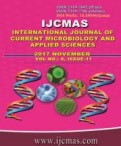


 National Academy of Agricultural Sciences (NAAS)
National Academy of Agricultural Sciences (NAAS)

|
PRINT ISSN : 2319-7692
Online ISSN : 2319-7706 Issues : 12 per year Publisher : Excellent Publishers Email : editorijcmas@gmail.com / submit@ijcmas.com Editor-in-chief: Dr.M.Prakash Index Copernicus ICV 2018: 95.39 NAAS RATING 2020: 5.38 |
Red soils (Alfisols) of Karnataka are low in total and available phosphorus (P). When soluble P sources are added, undergo transformation into unavailable forms with time. Native P compounds, some being highly insoluble are unavailable for plant uptake. Thus, knowing the changes in P fractions in different soils is much important for P recommendation. The objective of the study was to find out the fate of the applied phosphorus in soils of different P fertility in a finger millet-maize cropping system. An experiment with creation of five P fertility gradient strips (Very low, Low, Medium, High and Very high) in one and the same field followed by response of finger millet and maize crops to graded levels of P was undertaken at UAS, Bangalore. Soil P fractions were determined in a soil after the harvest of maize in a finger millet- maize cropping system. There was an increase in total-P, organic-P, reductant soluble-P, occluded-P and calcium-P fractions with the increased gradient strips from very low to very high applied with levels of P. Whereas, saloid-P, aluminium-P and iron-P are the slowly and plant available labile-P forms which were decreased as the P fertility gradients and dose of P addition increased. There was a direct relationship with addition, fixation and distribution of P fractions. Hence, continuous P fertilization can be restricted in soils of high and very high initial P status as the PUE was 20-40 per cent only in general leads to build-up and transformation in to non-labile P forms.
 |
 |
 |
 |
 |